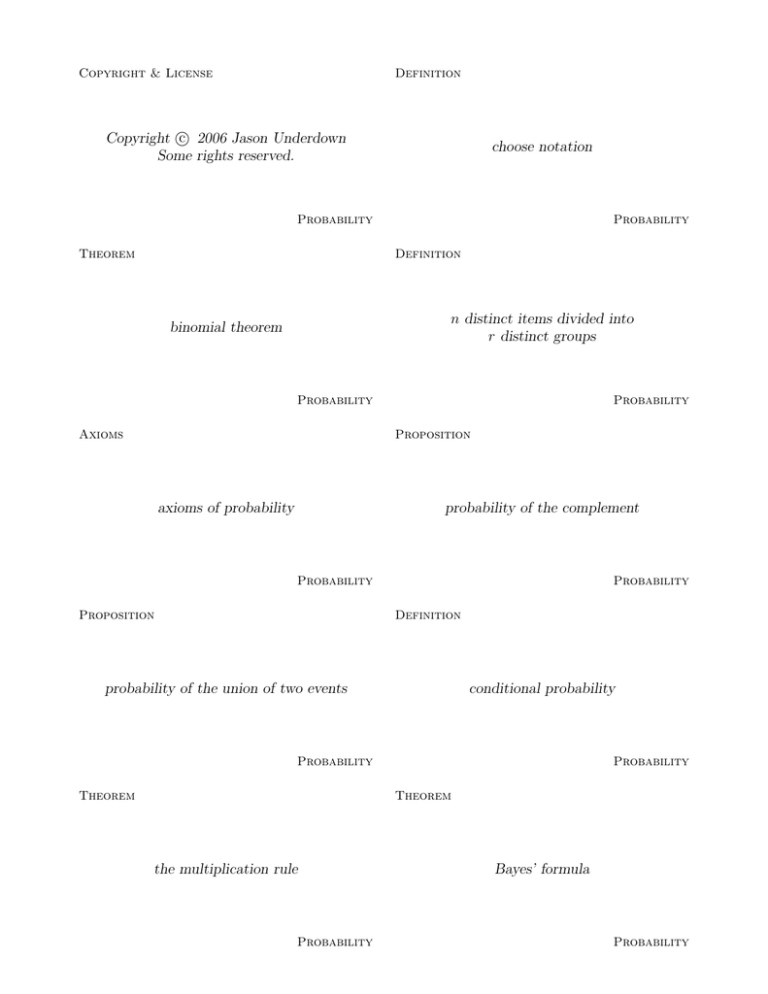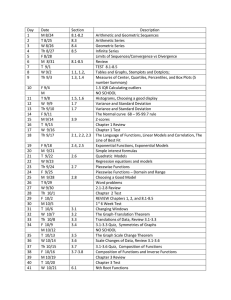
Definition
Copyright & License
c 2006 Jason Underdown
Copyright Some rights reserved.
choose notation
Probability
Theorem
Probability
Definition
n distinct items divided into
r distinct groups
binomial theorem
Probability
Axioms
Probability
Proposition
axioms of probability
probability of the complement
Probability
Proposition
Probability
Definition
probability of the union of two events
conditional probability
Probability
Theorem
Probability
Theorem
the multiplication rule
Probability
Bayes’ formula
Probability
n choose k is a brief way of saying how many ways can
you choose k objects from a set of n objects, when the
order of selection is not relevant.
n
n!
=
k
(n − k)! k!
Obviously, this implies 0 ≤ k ≤ n.
Suppose you want to divide n distinct items in to r
distinct groups each with size n1 , n2 , . . . , nr , how do
you count the possible outcomes?
If n1 + n2 + . . . + nr = n, then the number of possible
divisions can be counted by the following formula:
n!
n
=
n1 , n 2 , . . . , n r
n1 ! n2 ! . . . n r !
These flashcards and the accompanying LATEX source
code are licensed under a Creative Commons
Attribution–NonCommercial–ShareAlike 2.5 License.
For more information, see creativecommons.org. You
can contact the author at:
jasonu [remove-this] at physics dot utah dot edu
n
(x + y) =
n X
n
k=0
k
xk y n−k
1. 0 ≤ P (E) ≤ 1
2. P (S) = 1
If E c denotes the complement of event E, then
c
P (E ) = 1 − P (E)
3. For any sequence of mutually exclusive events
E1 , E 2 , . . .
(i.e. events where Ei Ej = ∅ when i 6= j)
!
∞
∞
[
X
P
Ei =
P (Ei )
i=1
i=1
If P (F ) > 0, then
P (E | F ) =
P (E)
P (EF )
P (F )
P (A ∪ B) = P (A) + P (B) − P (AB)
= P (EF ) + P (EF c )
= P (E | F )P (F ) + P (E | F c )P (F c )
= P (E | F )P (F ) + P (E | F c )[1 − P (F )]
P (E1 E2 E3 . . . En ) =
P (E1 )P (E2 | E1 )P (E3 | E2 E1 ) . . . P (En | E1 . . . En−1 )
Definition
Definition
probability mass function of a discrete
random variable
independent events
Probability
Definition
Probability
Theorem
cumulative distribution function F
properties of the cumulative distribution
function
Probability
Definition
Probability
Proposition
expected value
(discrete case)
expected value of a function of X
(discrete case)
Probability
Corollary
Probability
Definition/Theorem
linearity of expectation
variance
Probability
Definition
Probability
Definition
probability mass function of a
Bernoulli random variable
Probability
probability mass function of a
binomial random variable
Probability
For a discrete random variable X, we define the probability mass function p(a) of X by
Two events E and F are said to be independent iff
P (EF ) = P (E)P (F )
p(a) = P {X = a}
Probability mass functions are often written as a table.
Otherwise they are said to be dependent.
The cumulative distribution function satisfies the following properties:
The cumulative distribution function (F ) is defined to
be
X
F (a) =
p(x)
1. F is a nondecreasing function
2. lima→∞ F (a) = 1
all x≤a
The cumulative distribution function F (a) denotes the
probability that the random variable X has a value less
than or equal to a.
3. lima→−∞ F (a) = 0
If X is a discrete random variable that takes on the
values denoted by xi (i = 1 . . . n) with respective probabilities p(xi ), then for any real–valued function f
E[f (X)] =
n
X
E[X] =
X
xp(x)
x:p(x)>0
f (xi )p(x)
i=1
If X is a random variable with mean µ, then we define
the variance of X to be
var(X)
= E[(X − µ)2 ]
If α and β are constants, then
= E[X 2 ] − (E[X])2
E[αX + β] = αE[X] + β
= E[X 2 ] − µ2
The first line is the actual definition, but the second
and third equations are often more useful and can be
shown to be equivalent by some algebraic manipulation.
Suppose n independent Bernoulli trials are performed.
If the probability of success is p and the probability of
failure is 1 − p, then X is said to be a binomial random
variable with parameters (n, p).
The probability mass function is given by:
n i
p(i) =
p (1 − p)n−i
i
where i = 0, 1, . . . , n
If an experiment can be classified as either success or
failure, and if we denote success by X = 1 and failure
by X = 0 then, X is a Bernoulli random variable with
probability mass function:
p(0)
p(1)
=
=
P {X = 0}
P {X = 1}
=
=
1−p
p
where p is the probability of success and 0 ≤ p ≤ 1.
Theorem
Definition
properties of binomial random variables
probability mass function of a
Poisson random variable
Probability
Theorem
Probability
Definition
properties of Poisson random variables
probability mass function of a
geometric random variable
Probability
Theorem
Probability
Definition
properties of geometric random variables
probability mass function of a
negative binomial random variable
Probability
Theorem
Probability
Definition
properties of negative binomial random
variables
probability density function of a continuous
random variable
Probability
Definition
Probability
Theorem
probability density function of a
uniform random variable
Probability
properties of uniform random variables
Probability
A random variable X that takes on one of the values
0,1,. . ., is said to be a Poisson random variable with
parameter λ if for some λ > 0
λi
p(i) = P {X = i} = e−λ
i!
If X is a binomial random variable with parameters n
and p, then
E[X]
var(X)
= np
= np(1 − p)
where i = 0, 1, 2, . . .
Suppose independent Bernoulli trials, are repeated until success occurs. If we let X equal the number of trials required to achieve success, then X is a geometric
random variable with probability mass function:
If X is a Poisson random variable with parameter λ,
then
E[X]
= λ
var(X)
= λ
p(n) = P {X = n} = (1 − p)n−1 p
where n = 1, 2, . . .
Suppose that independent Bernoulli trials (with probability of succes p) are performed until r successes occur. If we let X equal the number of trials required,
then X is a negative binomial random variable with
probability mass function:
n−1 r
p (1 − p)n−r
p(n) = P {X = n} =
r−1
If X is a geometric random variable with parameter p,
then
E[X]
=
var(X)
=
1
p
1−p
p2
where n = r, r + 1, . . .
We define X to be a continuous random variable if
there exists a function f , such that for any set B of
real numbers
Z
f (x)dx
P {X ∈ B} =
B
If X is a negative binomial random variable with parameters (p, r), then
E[X]
=
var(X)
=
r
p
r(1 − p)
p2
The function f is called the probability density function
of the random variable X.
If X is a uniform random variable with parameters
(α, β), then
E[X]
=
var(X)
=
α+β
2
(β − α)2
12
If X is a uniform random variable on the interval
(α, β), then its probability density function is given
by
1
if α < x < β
β−α
f (x) =
0
otherwise







